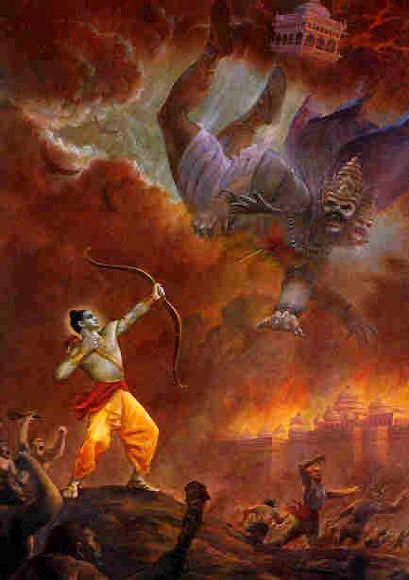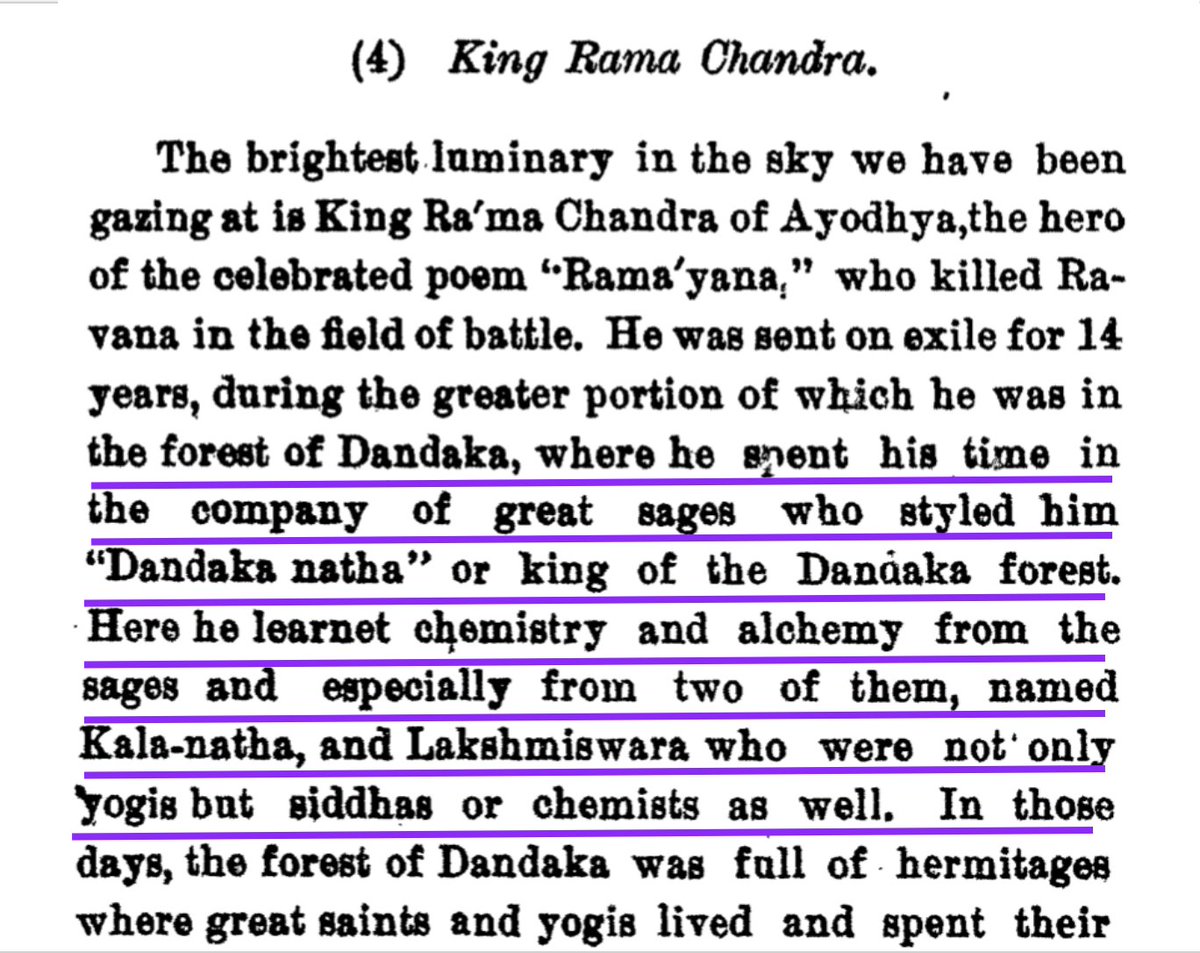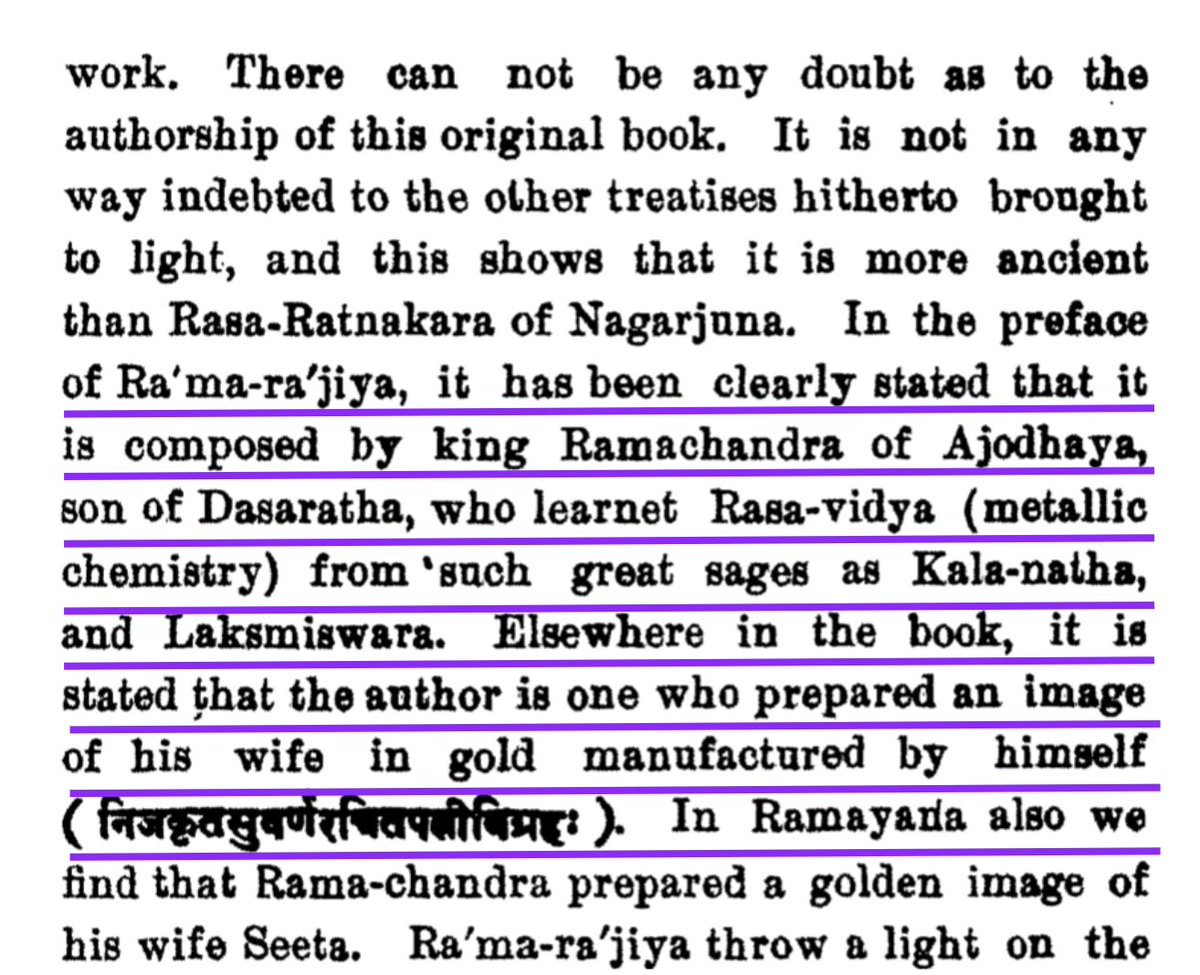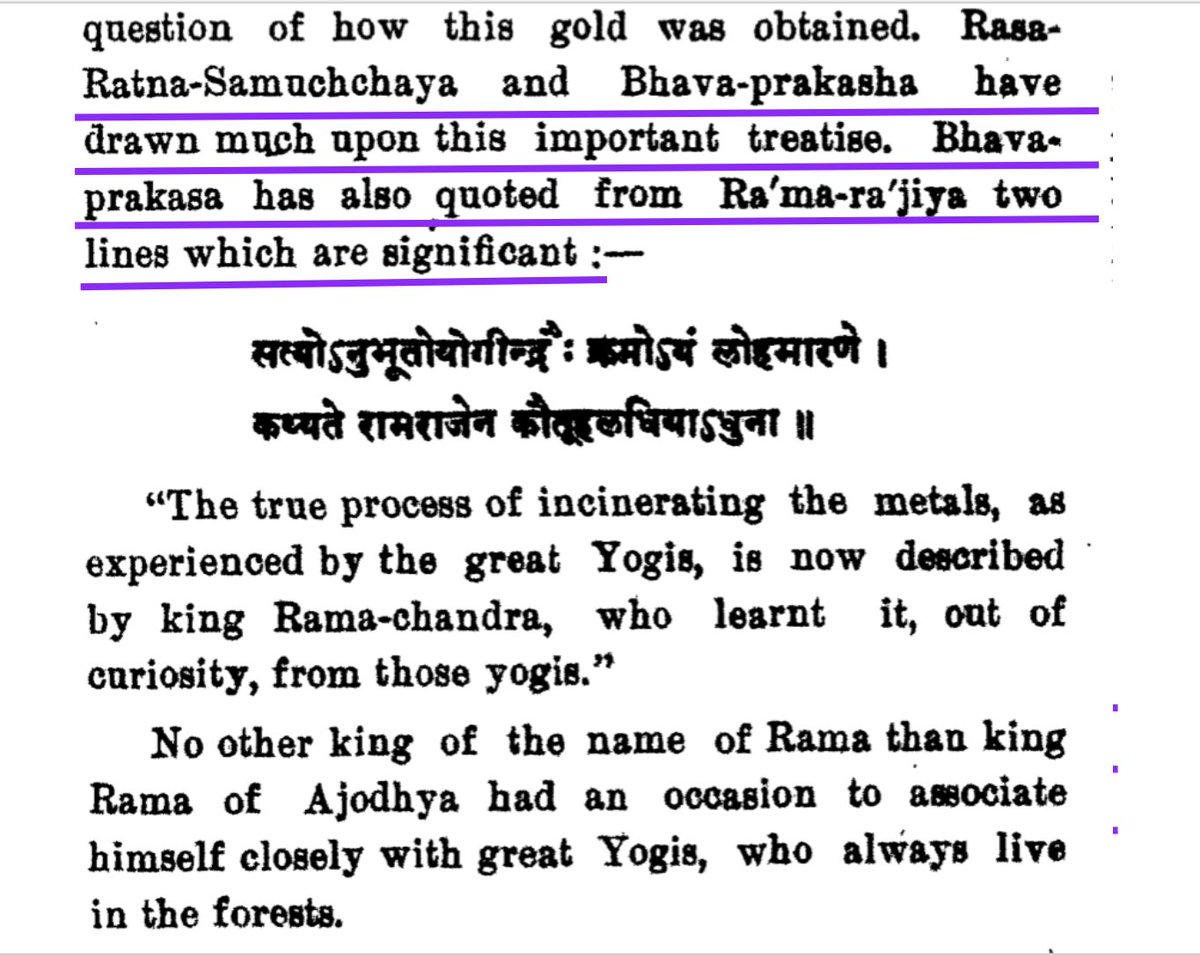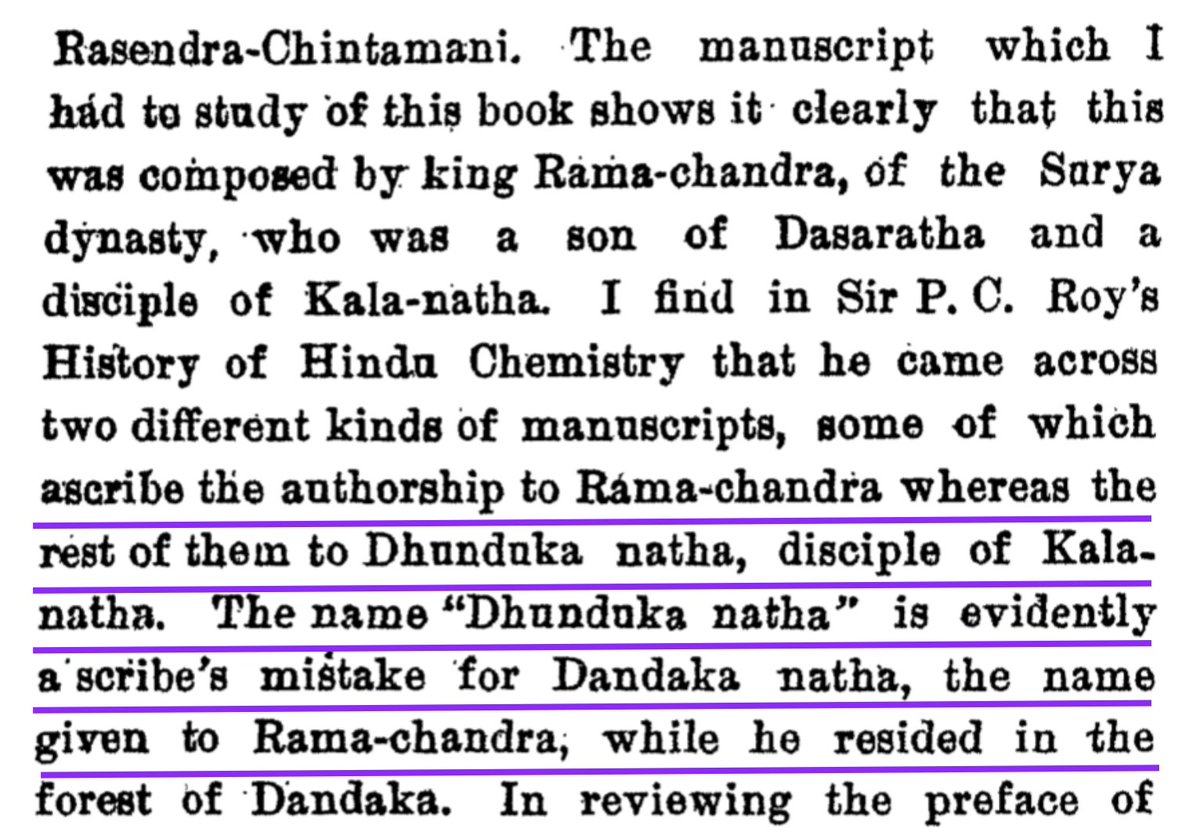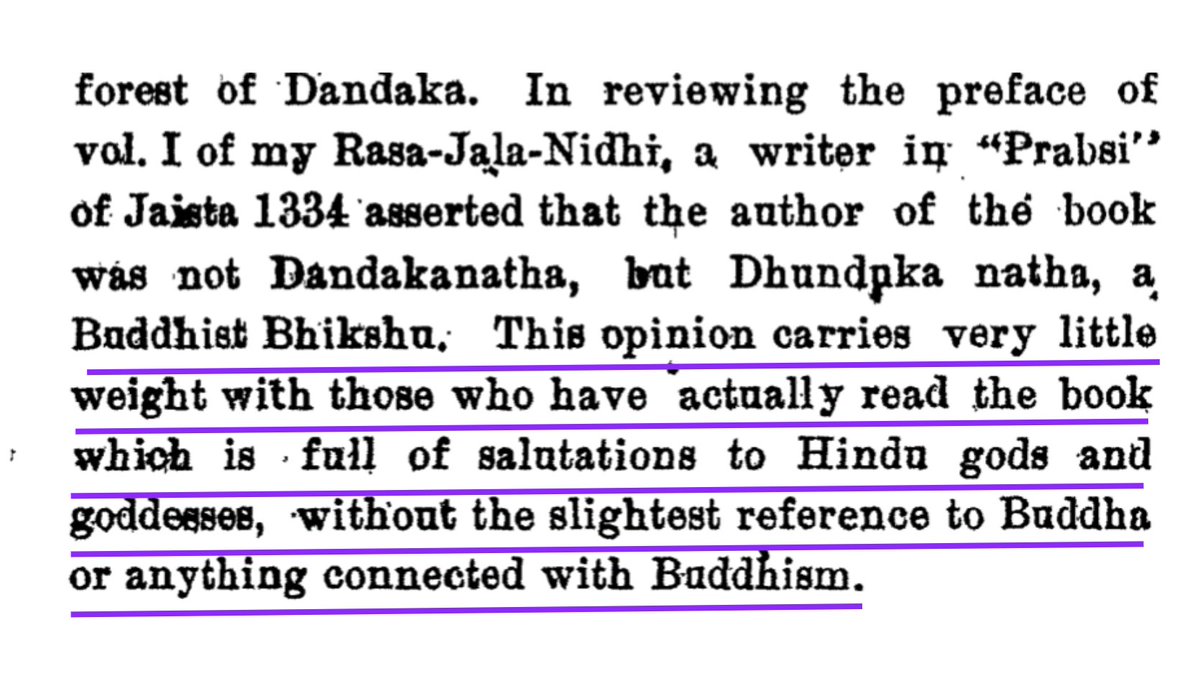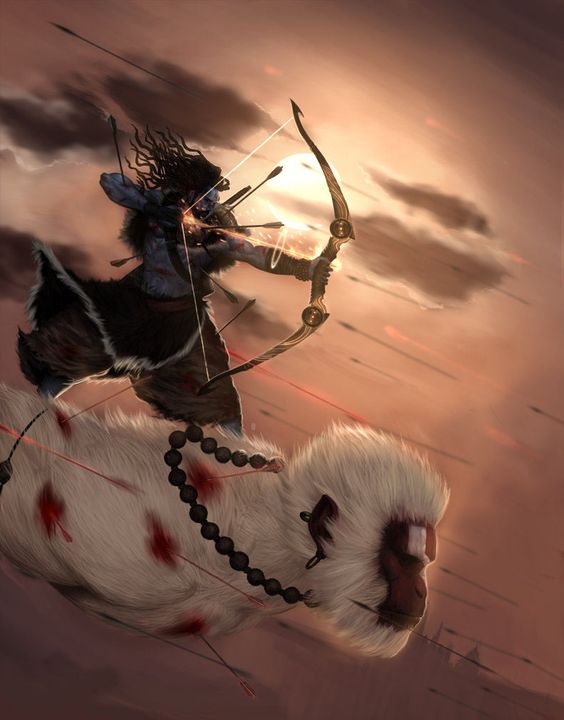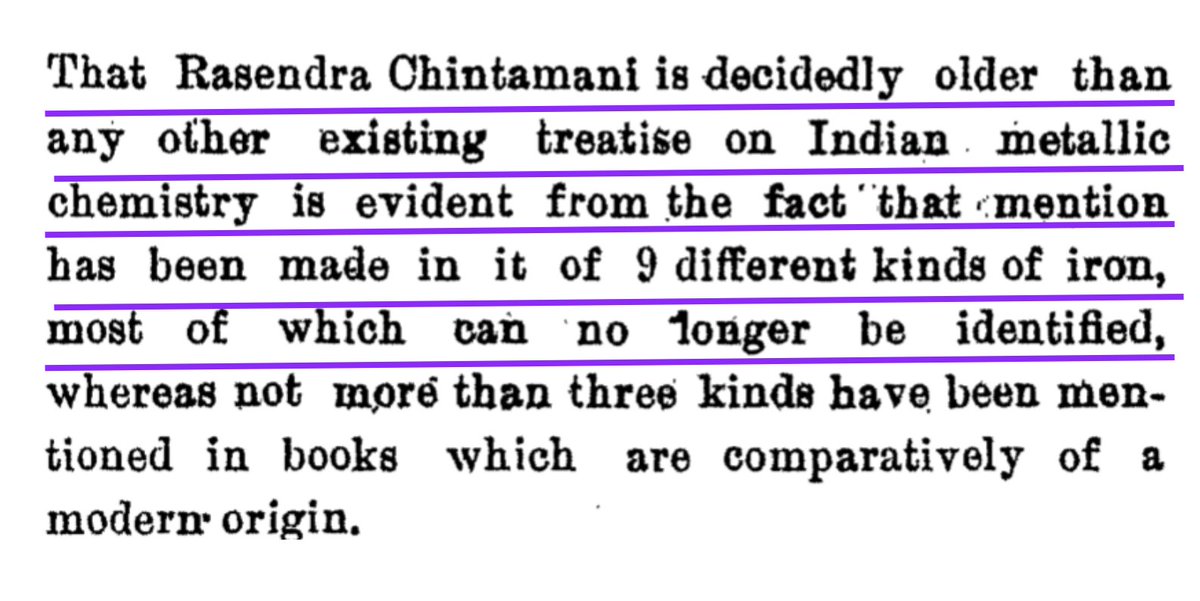1/n
Bhagwan Ram’s life is primarily known to us from references in texts such as the Ramayana & Vasistha’s Yoga. We know him as a king, hero & divine Avatar, but did you know that Shree Rama was a scientist & one of ancient India’s foremost experts on chemistry & metallurgy?
Bhagwan Ram’s life is primarily known to us from references in texts such as the Ramayana & Vasistha’s Yoga. We know him as a king, hero & divine Avatar, but did you know that Shree Rama was a scientist & one of ancient India’s foremost experts on chemistry & metallurgy?
2/n
Bhudeb Mookerjee, principal of Bengal College of Ayurveda was an Ayurvedic doctor & Sanskrit scholar. In 1938, he published “Rasa Jala Nidhi, Vol. 5” on Hindu chemistry. In Part 8, he directly names Shree Ramachandra as one of the greatest experts of ancient Hindu chemistry.
Bhudeb Mookerjee, principal of Bengal College of Ayurveda was an Ayurvedic doctor & Sanskrit scholar. In 1938, he published “Rasa Jala Nidhi, Vol. 5” on Hindu chemistry. In Part 8, he directly names Shree Ramachandra as one of the greatest experts of ancient Hindu chemistry.
3/n
He tells us that King Ramachandra of Ayodhya, learnt chemistry from two great Yogis & Siddhas (Chemists) named Kalanatha & Lakshmisvara in the Dandaka forest. Having gained expertise in the field of chemistry & metallurgy, he was named “Dandakanatha” by the sages.
He tells us that King Ramachandra of Ayodhya, learnt chemistry from two great Yogis & Siddhas (Chemists) named Kalanatha & Lakshmisvara in the Dandaka forest. Having gained expertise in the field of chemistry & metallurgy, he was named “Dandakanatha” by the sages.
4/n
There he authored a book on chemistry called “Ram Rajiya” Sadly, the original manuscript is not available, but reference to it are found in treatises Rasa-Ratna-Samuchchaya & Bhava-Prakasha. The book’s preface says the author is Dasharathputra, king Ramachandra of Ayodhya.
There he authored a book on chemistry called “Ram Rajiya” Sadly, the original manuscript is not available, but reference to it are found in treatises Rasa-Ratna-Samuchchaya & Bhava-Prakasha. The book’s preface says the author is Dasharathputra, king Ramachandra of Ayodhya.
5/n
It also mentions that the author learnt Rasa-vidya (metallic chemistry) from the great Rishis Kalanatha, and Laksmisvara. It states that the author prepared an image of his wife in gold manufactured by himself. Rama-Rajiya tells us the process of how this gold was obtained.
It also mentions that the author learnt Rasa-vidya (metallic chemistry) from the great Rishis Kalanatha, and Laksmisvara. It states that the author prepared an image of his wife in gold manufactured by himself. Rama-Rajiya tells us the process of how this gold was obtained.
6/n
Rasa-Ratna-Samuchchaya & Bhava-prakasha drew much source material from the “Ram Rajiya”. The Bhava-Prakasha quotes :
“The true process of incinerating Loha-bhasma (metals) as experienced by the great Yogis, is described by king Rama-chandra, who learnt it from those yogis.”
Rasa-Ratna-Samuchchaya & Bhava-prakasha drew much source material from the “Ram Rajiya”. The Bhava-Prakasha quotes :
“The true process of incinerating Loha-bhasma (metals) as experienced by the great Yogis, is described by king Rama-chandra, who learnt it from those yogis.”
7/n
Although the original manuscript of “Ram-Rajiya” is lost, there exists yet another chemistry treatise written by Shree Rama called Rasendra-Chintamani which was mistaken as a Buddhist text by most scholars including PC Ray, due to later corruptions & insertions.
Although the original manuscript of “Ram-Rajiya” is lost, there exists yet another chemistry treatise written by Shree Rama called Rasendra-Chintamani which was mistaken as a Buddhist text by most scholars including PC Ray, due to later corruptions & insertions.
8/n
This is because the author of Rasendra-Chintamani has been erroneously copied as “Dhunduka-natha, disciple of Kala-natha” . This is evidently a scribe’s mistake for Dandaka-natha, the name given to Rama-chandra. Buddhists claim that Dhunduka natha was a Buddhist Bhikshu
This is because the author of Rasendra-Chintamani has been erroneously copied as “Dhunduka-natha, disciple of Kala-natha” . This is evidently a scribe’s mistake for Dandaka-natha, the name given to Rama-chandra. Buddhists claim that Dhunduka natha was a Buddhist Bhikshu
9/n
But as Bhudeb Mookerjee points out, the teacher’s name of Kalanatha corroborates the Ram-Rajiya. Rasendra-Chintamani can’t be a Buddhist work as the book is full of salutations to Hindu gods and goddesses, without any reference to Buddha or Buddhism.
But as Bhudeb Mookerjee points out, the teacher’s name of Kalanatha corroborates the Ram-Rajiya. Rasendra-Chintamani can’t be a Buddhist work as the book is full of salutations to Hindu gods and goddesses, without any reference to Buddha or Buddhism.
10/n
Moreover Rasendra-Chintamani is clearly composed by two different authors—one ancient and another modern, one original and another commentator, the original composition, by Rama in elegant verse, & the commentary of later origin, is mainly, in prose.
Moreover Rasendra-Chintamani is clearly composed by two different authors—one ancient and another modern, one original and another commentator, the original composition, by Rama in elegant verse, & the commentary of later origin, is mainly, in prose.
11/n
The first layer of composition is of a very ancient origin and has no reference, to such modern chemists as Nagarjuna, Nityanatha, etc. whereas the second layer contains such references. This led scholars to erroneously date the work to 14th century A. D.
The first layer of composition is of a very ancient origin and has no reference, to such modern chemists as Nagarjuna, Nityanatha, etc. whereas the second layer contains such references. This led scholars to erroneously date the work to 14th century A. D.
12/n
That the Rasendra Chintamani is older than other existing treatises on Indian metallic chemistry is evident from the fact that it mentions 9 different kinds of iron, most of which can no longer be identified, Only 3 kinds are mentioned in books of a modern origin.
That the Rasendra Chintamani is older than other existing treatises on Indian metallic chemistry is evident from the fact that it mentions 9 different kinds of iron, most of which can no longer be identified, Only 3 kinds are mentioned in books of a modern origin.
13/n
These amazing references give us a whole new perspective on the multi faceted personality of, Shree Rama or Dandakanatha. Not only was he a historical figure, but also one of India’s most respected scientists who authored two invaluable books on chemistry & metallurgy.
These amazing references give us a whole new perspective on the multi faceted personality of, Shree Rama or Dandakanatha. Not only was he a historical figure, but also one of India’s most respected scientists who authored two invaluable books on chemistry & metallurgy.
14/n
All volumes of “Rasa Jala Nidhi” by Bhudeb Mookerjee, consisting of comprehensive Ayurvedic formulas & references to Hindu chemistry are available for download at:
https://archive.org/details/RasaJalaNidhiOrOceanOfIndianChemistryVol2-5/">https://archive.org/details/R...
All volumes of “Rasa Jala Nidhi” by Bhudeb Mookerjee, consisting of comprehensive Ayurvedic formulas & references to Hindu chemistry are available for download at:
https://archive.org/details/RasaJalaNidhiOrOceanOfIndianChemistryVol2-5/">https://archive.org/details/R...

 Read on Twitter
Read on Twitter